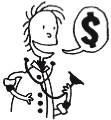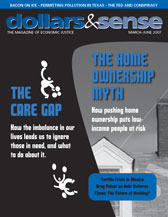
Dear Dr. Dollar:
Some of my friends believe that the Federal Reserve
and international bankers (Rothschilds, Rockefellers,
etc.) run the world. They think the Federal Reserve
was formed in secret and is pretty much a conspiracy. This
is all hooked up with other conspiracy theories and rightwing
views that make me uncomfortable. What do you think?
Isn't the banking system part of the whole capitalist system?
How does the Federal Reserve work; does it really have so much power?
—Carol Brown, New York, N.Y.
This article is from the Spring 2007 issue of Dollars & Sense: The Magazine of Economic Justice available at http://www.dollarsandsense.org

This article is from the Spring 2007 issue of Dollars & Sense magazine.
Subscribe Now
at a 30% discount.
The Federal Reserve is a very powerful institution, and the people who run the world’s large banks are a very powerful group of people. No one would claim otherwise. Also, the bankers have common interests, and, like any other group of people with common interests, they do what they can to bring about government policies that favor those interests.
Because the Federal Reserve (the “Fed”), as the central bank of the United States, implements policies that most directly affect the bankers, they of course are quite concerned with what the Fed does, how it is structured, and who runs it. And, like other elite groups, bankers certainly meet in private—in “secret,” if one prefers—to figure out how best to get what they want.
With all that said, however, the idea that a small cabal of bankers runs the world through the operations of the Fed is wrong on several counts.
First of all, financial operatives are not the only powerful economic group. There are, for example, the people who run the large oil companies, the Silicon Valley operations, and the pharmaceutical firms, to name a few of the currently important capitalist clusters. These other groups have some common interests with the bankers, and they often all work together, both in private and in public, to achieve their common ends; they do not call in the press every time a few of them meet. (A recent example: when Vice President Cheney held a meeting to formulate the Bush administration’s energy policy, the list of attendees—widely assumed to be top energy sector executives—was kept secret.) But to boil down this large class of people to a few bankers both distorts reality and obscures the conflicts that sometimes exist among them.
Second, not only are there often differences among these groups, but there are often contradictions between different things that they want. For example, they want a well-trained work force, but they do not want the high taxes that would be needed to pay for that training; they want freedom from government regulations, but they want the economic stability that often depends on government regulation; they want free access to international markets, but they want special preferences (as compared to foreign companies) within the United States; they want to pay low wages, but they want a populace with enough income to buy their products.
Third, while this set of people is undoubtedly very powerful in affecting the operation of our economic lives and in shaping history, they do not shape history just as they please. They simply can’t control everything—as the problem that the Fed has with long-term interest rates illustrates (see below). They cannot control the economy just as they would like and they cannot control the rest of us just as they would like. Formal democracy, however limited, is a useful device. The power that the rest of us have can be a substantial constraint on the actions of big business—bankers, energy executives, and all the others.
But let’s return to the Fed. What does it do, and how? The Fed has a variety of functions involving regulation of the banking system, including influencing the amount of money in circulation and interest rates (the price people pay to use other people’s money). Of special importance, the Fed can influence the amount of loans that banks issue. When a bank issues a loan, this creates more spending power. This spending power (usually in the form of increasing the amount in the borrower’s checking account) is the same thing as more money in circulation. So by influencing banks’ loan actions, the Fed influences the money supply.
Right-wingers who view the Fed and the banks as an evil cabal tend to claim that by allowing banks to increase the money supply, the Fed is debasing our currency. The increased money supply lowers the value of money in relation to other goods, and the money prices of other goods rise—i.e., inflation. Moreover, they view this as a way of allowing the government to engage in excessive spending: the government can borrow from the public, but then, because of inflation, can repay in dollars that have less worth.
This fascination of some right-wingers with inflation and the debasement of the currency is ironic because, in fact, the Fed often (although not always) acts in exactly the opposite manner—limiting the growth of the money supply and restricting inflation. Banks, and businesses generally, like stable prices and stable interest rates. One reason is that a low-inflation policy keeps unemployment rates higher than they otherwise would be, weakening the bargaining power of workers and shifting the distribution of income in favor of capitalists.
A further irony: the Fed is not as powerful as either its proponents or its critics think. The Fed really has control only over short-term interest rates. Long-term interest rates, however, are more important (as they affect major investment decisions) and are influenced by many forces beyond the Fed’s control. The expectations of business about future ups and downs of the economy—and about the myriad events that affect those fluctuations— are the central factors determining long-term interest rates. Neither capitalists’ behavior nor capitalist economies are so easily controlled. If they were, then there would never be any stock market crashes, burst financial bubbles, or other serious disruptions.
By the way, the Fed was not formed in secret. The Fed was created by legislative action, formally and publicly. But there were certainly private (secret) meetings that laid the groundwork for it. Of course, the same is true of legislative actions affecting the pharmaceutical industry, Silicon Valley, insurance firms, and the list goes on. Nothing that special about the creation of the Fed. Finally, while I am sure that there are many decent people who see the Fed and the bankers as the source of the world’s problems, this view is often part of a larger anti-Semitism. The focus on “Jewish financiers” (the Rothschilds, for example) as the source of our economic and other problems is as old as it is wrong and offensive.
Did you find this article useful? Please consider supporting our work by donating or subscribing.
